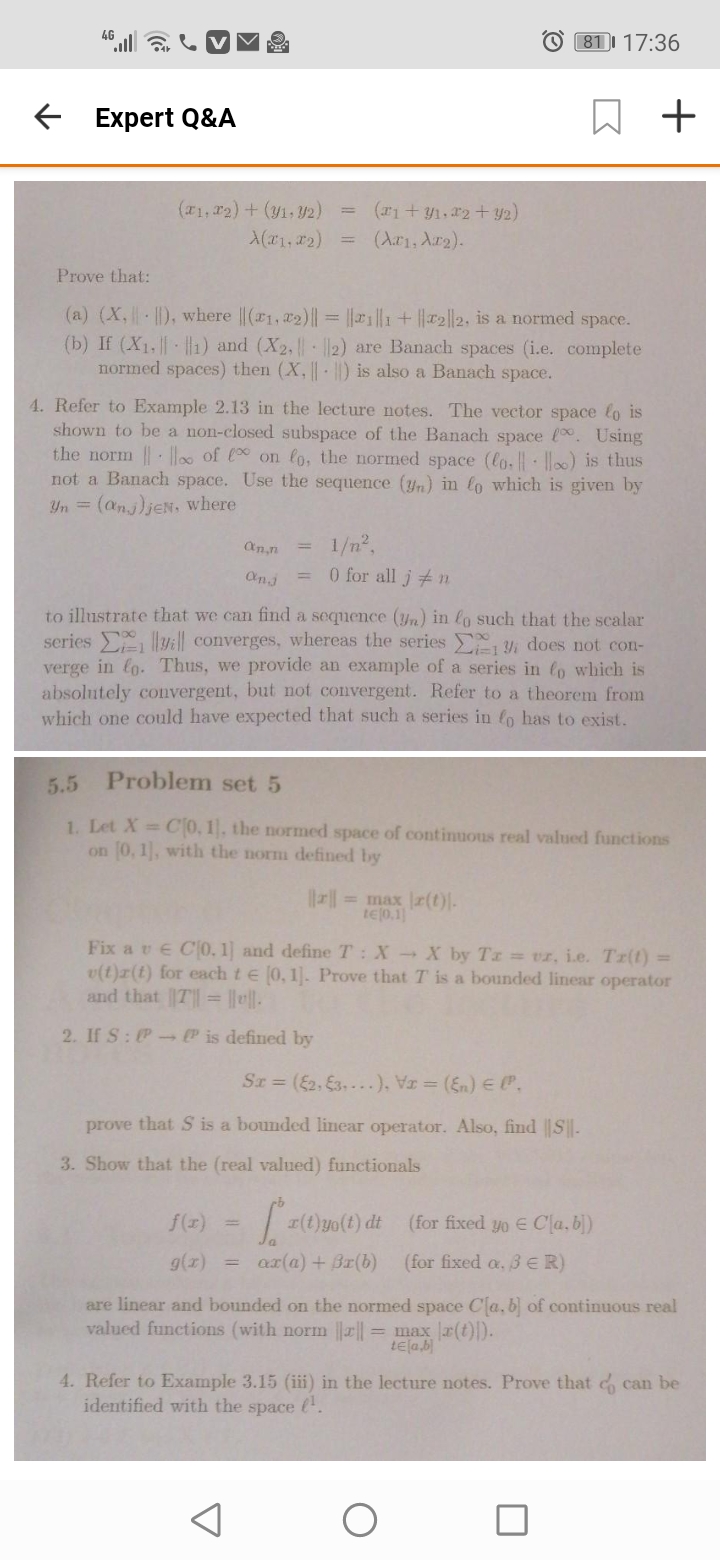Functional analysis Questions
81 17:36 - Expert Q&A W + 2. A subset M of a normed space X is said to be conver if x, y e M implies that { z EX : 2 = ax + ( 1 - c ) y, 0 s as1}cM, i.e. if the "line joining a and y" is completely contained in M for every choice of r, y E M. Prove that the closed unit ball B1 (0) = {= EX : |/all s1} in any normed space X is convex. 3. Suppose that (X1, II . li) and (X2. (| . ((2) are two normed spaces. Let X = X1 x X2 = {(21, 42) : 51 ( X1, 12 (X2} be the product vector space, where the operations addition and scalar multiplication are defined by (21, 72) + (31, 32) = (21+ 91.22+92) A(x1, x2) = (X.r1, Xx2). Prove that: (a) (X, | . [1), where (21, 22)ll = zilli + x2ll2, is a normed space. (b) If (X1, ll . (1) and (X2, (1 . (/2) are Banach spaces (i.e. complete normed spaces) then (X, [| . () is also a Banach space. 4. Refer to Example 2.13 in the lecture notes. The vector space 60 is shown to be a non-closed subspace of the Banach space (%%. Using the norm | . loo of (x on 60, the normed space (lo, II . lloo) is thus not a Banach space. Use the sequence (Un) in fo which is given by Un = (anj)jen, where ann = 12, = 0 for all j # n to illustrate that we can find a sequence (Un) in fo such that the scalar series _, llyill converges, whereas the series _y, does not con- verge in fo. Thus, we provide an example of a series in 60 which is absolutely convergent, but not convergent. Refer to a theorem from which one could have expected that such a series in 6 has to exist. 5.5 Problem set 5 1. Let X = C[0, 1], the normed space of continuous real valued functions on [0, 1], with the norm defined by Iall = max |z(t). Fix a v E CO. 1] and define T : X - X by Tx = ur, i.e. Tz(1) = u(t)r(t) for each t e [0, 1). Prove that T is a bounded linear operator and that IT = Hull. O81 17:36 - Expert Q&A (ii) Then show that (X, d) is a metric space. (iii) Note that each Cauchy sequence in X belongs to some equivalence class a, since each Cauchy sequence is at least equivalent to itself. Further, note that a Cauchy sequence (In) can only belong to one equivalence class, because each equivalence class contains all the Cauchy sequences in X which are equivalent to (C.). Therefore it makes sense to define a function h : X - X as follows: h(x) = 4, where (3, x, . .. ) ex. Show that the function h satisfies d (h(x), h(y)) = d(x, y). for all a, y e X. Remark: A function f : X - Y from a metric space (X, d) to a metric space (Y, p) is called an isometry if the property p(f (x), f(y)) = d(x, y), Va, y ex holds. It is clear that an isometry is injective. If it is also surjec- tive (thus a bijection), then we say the two metric spaces (X, d) and (Y, p) are isometric. Isometric metric spaces can be regarded to be "the same". Remark: The construction of (X, d) in Problem 4 above provides us with a complete metric space X such that X is isometric with a subset of X which is dense in X; thus the mapping h in Problem 4 is an isometry from X onto h(X) and the metric space (h(X), d) is dense in X; i.e. h(X) = X. We call X the completion of X. 1. On the vector space R2, consider the following (equivalent) norms: 1(21, 02) |/1 = lail+ 1021 1 (01, 02) /12 = (03+ 03) 1/2 1(a1, 02)|loo = max{|01], [a2/}. The unit sphere in a normed space X is given by S(0; 1) = {x EX : |x| =1}. Sketch the unit spheres of the normed spaces (R2, ]| . |1), (12, II - (12) and (R2, | . loo), respectively. 2. A subset M of a normed space X is said to be conver if z, y e M implies that { z EX : 2 = ax + ( 1 - c ) y, 0











